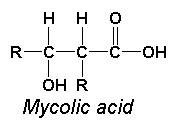|
Mycobacterium
ORGANISM:
- Genus: Mycobacterium
- Species: tuberculosis, leprae
GENERAL CONCEPTS:

- Mycobacteria belong in the family Mycobacteriaceae and are part of the CMN group (Corynebacteria, Mycobacteria and Nocardia).
- The family Mycobacteriaceae are Gram-positive, nonmotile, catalase-positive and have a rodlike to filamentous morphology (Corynebacteria are often pleomorphic).
- As a group, they produce characteristic long chain fatty acids termed mycolic acids. In the image to the right, the R-groups represent these chains. For Corynebacteria, chains of 28-40 carbons are common; for Nocardia, chains of 40-56 carbons are produced; for Mycobacteria, the chains are 60-90 carbons in length.
DISTINCTIVE PROPERTIES:
- Mycobacteria are considered "acid-fast", which means that they retain dyes following an acid-alcohol decolorization step.
- These organisms are very slow growers; a 5 hour division time is not uncommon.
- Different species can be differentiated based on growth rate, niacin secretion, reduction of nitrate, caratogenesis, etc.
- Mycobacteria produce "cord factors", which are dimycolates of trehalose. This gives rise to a pattern of growth in serpentine cords.
- The very lipid nature of the cell wall provides some resistance to drying, acid or alkaline conditions. It is also a good adjuvant that enhances humoral and cell-mediated immune responses. The responsible component may be N-acetyl-muramyl-L-alanyl-D-isoglutamine (MDP), which causes the inhibition of macrophage migration.
- M. leprae has never been cultured in vitro but can be grown on the footpads of armadillos.
PATHOGENESIS:
- M. tuberculosis is the agent responsible for the disease tuberculosis.
- Virulent strains of Mycobacteria have the capacity to disrupt phagosomal membranes of alveolar macrophages while the cord factors inactivate mitochondrial membranes of phagocytes. These properties enable the organisms to survive and multiply in phagocytes.
- Leprosy is caused by M. leprae and may appear in one of two forms; tuberculoid or lepromatous.
HOST DEFENSES:
- It is the cell-mediated immune response (delayed hypersensitivity) that leads to the production of the granulomatous lesion known as a tubercle. This lesion contains a core of rounded macrophages, surrounded by outer giant cells. Persistence of the lesion gives rise to a cheesy caseation necrosis and, eventually, calcification.
EPIDEMIOLOGY:
- Tuberculosis is spread by airborne droplets that must penetrate deep into the respiratory tree.
- With the AIDS epidemic, the number of multiple drug resistant (MDR) strains has increased, making it even more difficult to treat cases.
DIAGNOSIS:
- Clinical: Tuberculosis is characterized by a prolonged and productive cough.
- Laboratory: Performing an acid-fast stain on sputum can reveal the bacteria. A skin test can ascertain exposure, but only where the Bacille Calmette-Guerin (BCG) vaccine is not used regularly.
CONTROL:
- Sanitary: Treatment and quarantine of cases reduces the rate.
- Immunological: BCG vaccine is available. In the US, this is used to test for exposure; in other areas of the world, it is used to prevent disease.
- Chemotherapeutic: Isoniazid, rifampin and ethambutol are the drugs used to treat tuberculosis, often in combination and often for many months. Rifampin is used for leprosy.
|
|